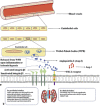Impact of Angiopoietin-2 on Kidney Diseases
- PMID: 38306230
- PMCID: PMC10826602
- DOI: 10.1159/000529774
Impact of Angiopoietin-2 on Kidney Diseases
Abstract
Background: Angiopoietins (Ang) are essential angiogenic factors involved in angiogenesis, vascular maturation, and inflammation. The most studied angiopoietins, angiopoietin-1 (Ang-1) and angiopoietin-2 (Ang-2), behave antagonistically to each other in vivo to sustain vascular endothelium homeostasis. While Ang-1 typically acts as the endothelium-protective mediator, its context-dependent antagonist Ang-2 can promote endothelium permeability and vascular destabilization, hence contributing to a poor outcome in vascular diseases via endothelial injury, vascular dysfunction, and microinflammation. The pathogenesis of kidney diseases is associated with endothelial dysfunction and chronic inflammation in renal diseases.
Summary: Several preclinical studies report overexpression of Ang-2 in renal tissues of certain kidney disease models; additionally, clinical studies show increased levels of circulating Ang-2 in the course of chronic kidney disease, implying that Ang-2 may serve as a useful biomarker in these patients. However, the exact mechanisms of Ang-2 action in renal diseases remain unclear.
Key messages: We summarized the recent findings on Ang-2 in kidney diseases, including preclinical studies and clinical studies, aiming to provide a systematic understanding of the role of Ang-2 in these diseases.
Keywords: Angiogenesis; Angiopoietin-2; Kidney diseases.
© 2023 The Author(s). Published by S. Karger AG, Basel.
Conflict of interest statement
The named authors declare no conflict of interest.
Figures


References
-
- Futrakul N, Butthep P, Futrakul P. Altered vascular homeostasis in chronic kidney disease. Clin Hemorheol Microcirc. 2008;38(3):201–7. - PubMed
Publication types
LinkOut - more resources
Full Text Sources
Medical
Miscellaneous

